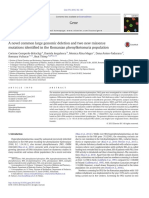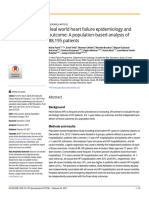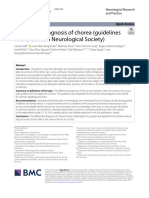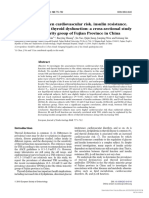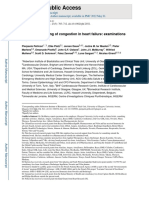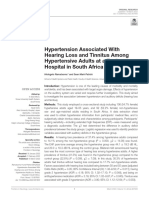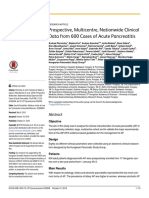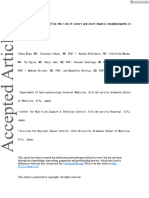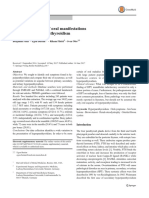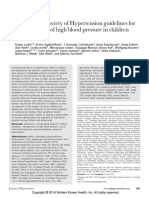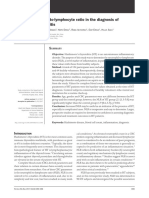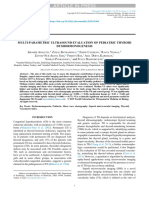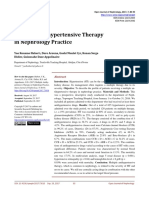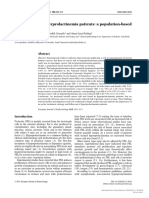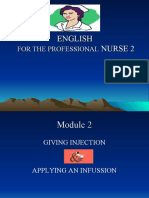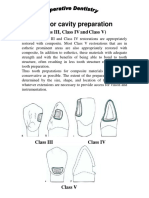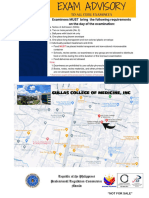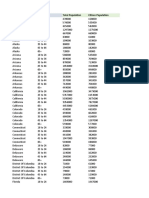Does Arterial Hypertension Influence The Onset of Huntington's Disease?
Does Arterial Hypertension Influence The Onset of Huntington's Disease?
Uploaded by
carlosCopyright:
Available Formats
Does Arterial Hypertension Influence The Onset of Huntington's Disease?
Does Arterial Hypertension Influence The Onset of Huntington's Disease?
Uploaded by
carlosOriginal Title
Copyright
Available Formats
Share this document
Did you find this document useful?
Is this content inappropriate?
Copyright:
Available Formats
Does Arterial Hypertension Influence The Onset of Huntington's Disease?
Does Arterial Hypertension Influence The Onset of Huntington's Disease?
Uploaded by
carlosCopyright:
Available Formats
RESEARCH ARTICLE
Does arterial hypertension influence the
onset of Huntington’s disease?
Leire Valcárcel-Ocete1, Asier Fullaondo1, Gorka Alkorta-Aranburu2, Marı́a Garcı́a-
Barcina3, Raymund A. C. Roos4, Lena E. Hjermind5, Carsten Saft6, Marina Frontali7,
Ralf Reilmann8, Hugh Rickards9, The REGISTRY investigators of the European
Huntington’s Disease Network (EHDN)¶, Ana M. Zubiaga1, Ana Aguirre1*
1 Department of Genetics, Physical Anthropology and Animal Physiology, University of the Basque Country
(UPV/EHU), Leioa, Spain, 2 Human Genetics, University of Navarra, Navarra, Spain, 3 Genetics Unit,
Basurto University Hospital, OSI Bilbao Basurto, Bilbao, Spain, 4 Department of Neurology, Leiden University
Medical Centre (LUMC), Leiden, The Netherlands, 5 Danish Dementia Research Centre, Neurogenetics
a1111111111 Clinic, Department of Neurology, Rigshospitalet, University of Copenhagen, Copenhagen, Denmark,
a1111111111 6 Huntington-Zentrum (NRW) Bochum, St. Josef-Hospital, Bochum, Germany, 7 Institute of Experimental
a1111111111 Medicine, CNR, Rome, Italy, 8 George-Huntington Institute and Institute for Clinical Radiology, University of
a1111111111 Muenster, and Dept. of Neurodegenerative Diseases and Hertie Institute of Clinical Brain Research,
University of Tuebingen, Germany, 9 Department of Neurology, University of Birmingham, Birmingham,
a1111111111
United Kingdom
¶ Membership of the REGISTRY investigators of the European Huntington’s Disease Network is provided in
the Acknowledgments.
* ana.aguirre@ehu.eus
OPEN ACCESS
Citation: Valcárcel-Ocete L, Fullaondo A, Alkorta-
Aranburu G, Garcı́a-Barcina M, Roos RAC, Abstract
Hjermind LE, et al. (2018) Does arterial
hypertension influence the onset of Huntington’s Huntington’s disease (HD) age of onset (AO) is mainly determined by the length of the CAG
disease? PLoS ONE 13(5): e0197975. https://doi. repeat expansion in the huntingtin gene. The remaining AO variability has been attributed to
org/10.1371/journal.pone.0197975
other little-known factors. A factor that has been associated with other neurodegenerative
Editor: David Blum, Centre de Recherche Jean- diseases is arterial hypertension (AHT). The aim of this study is to evaluate the contribution
Pierre Aubert, FRANCE
of AHT to the AO of HD. We used data from a cohort of 630 European HD patients with adult
Received: May 31, 2017 onset collected by the REGISTRY project of the European Huntington’s Disease Network.
Accepted: May 13, 2018 Multiple linear regression and ANOVA, controlling for the CAG repeat number of the
Published: May 23, 2018 expanded allele (CAGexp) of each patient, were performed to assess the association
between the AHT condition and the AO of the motor symptoms (mAO). The results showed
Copyright: © 2018 Valcárcel-Ocete et al. This is an
open access article distributed under the terms of a significant association between AHT and mAO, especially when we only considered the
the Creative Commons Attribution License, which patients diagnosed with AHT prior to manifesting any HD signs (pre-HD AHT). Remarkably,
permits unrestricted use, distribution, and despite the low number of cases, those patients developed motor symptoms 5–8 years later
reproduction in any medium, provided the original
author and source are credited.
than normotensive patients in the most frequent CAGexp range (40–44). AHT is an age-
related condition and consequently, the age of the patient at the time of data collection could
Data Availability Statement: All relevant data are
within the paper and its Supporting Information
be a confounder variable. However, given that most pre-HD AHT patients included in our
files. study had started treatment with antihypertensive drugs prior to the onset of HD, and that
Funding: This study was funded by Basque
antihypertensive drugs have been suggested to confer a neuroprotective effect in other
Government Department of Industry grants neurodegenerative diseases, raises the interest in elucidating the impact of AHT and/or
(Saiotek PE08UN78 and University-Company AHT treatment in HD age of onset in further studies. A confirmation of our results in a larger
Program 09+ UEGV096/C01), by the Basque
sample set would open the possibility to significantly improve HD management.
Government Department of Education (IT634-13)
and by the University of the Basque Country UPV/
EHU (UFI11/20). No funding bodies had any role in
PLOS ONE | https://doi.org/10.1371/journal.pone.0197975 May 23, 2018 1 / 11
Huntington’s disease onset and hypertension
study design, data collection and analysis, decision
to publish, or preparation of the manuscript.
Competing interests: The authors have declared Introduction
that no competing interests exist.
Huntington’s disease (OMIM: 143100) AO is mainly (about 60%) determined by the length of
the CAG repeat expansion (CAGexp) in the HTT gene. The remaining variability has been
attributed to genetic and little-explored environmental factors [1]. Arterial Hypertension
(AHT) is a risk factor for numerous diseases with controversial effect on neurodegenerative
diseases [2]. The impact of AHT on HD has not been examined to date. The aim of this study
was to explore whether AHT could be an AO modifier factor for HD.
Methods
European Huntington’s Disease Network’s (EHDN) REGISTRY project provided data on
1,011 HD individuals. For this study, we gathered information on mAO [3], sex and age at the
time of data collection of 630 European adult-onset HD patients with CAGexp ranging
between 40 and 50, with known AHT status (86 hypertensives vs. 544 normotensives) and with
AHT onset date available in the REGISTRY dataset. The 40–50 CAGexp range was selected to
avoid the inclusion of juvenile-onset HD cases and thus, the introduction of errors in the
regression analysis [3–5]. Furthermore, 40–50 CAGexp was the repeat range of hypertensive
patients in our sample. Consequently, comparisons were performed between hypertensives
and normotensives exhibiting equivalent CAGexp distribution. Ethical approval and written
informed consents for each participant were obtained by the EHDN from the local ethics com-
mittees (http://www.euro-hd.net/html/registry), in compliance with the Declaration of Hel-
sinki, the International Conference on Harmonisation—Good Clinical Practice (CH-GCP),
and local regulations. Specific ethical approval of the study was obtained from the Clinical
Research Ethics Committee of the Basque Country (CEIC- Euskadi), the Human Research
Ethics Committee of the University of the Basque Country (CEISH) and the EHDN Scientific
Bioethical Advisory Committee (SBAC). Multiple linear regression and ANCOVA tests were
used to analyze the relationship between mAO and AHT, using CAGexp value as a covariate
in each regression. Kolmogorov-Smirnov (K-S) test was used to compare CAGexp and mAO
distributions between normotensive and hypertensive patients, while Mann-Whitney U test
was used, in the same way, to compare the medians(SPSS ver.23.0; SPSS Inc.).
Results
In patients with CAGexp ranging between 40 and 50, AHT explains HD mAO variability sig-
nificantly (regression analysis P = 0.016, Table 1; ANCOVA test P = 0.004). Remarkably, mAO
in HD patients with AHT was manifested on average 7 years later than in normotensives (52.5
vs. 45 years, P<0.0001), suggesting that AHT is associated with the appearance of motor symp-
toms at a later age. A significant association between AHT and a higher mAO was still detected
in patients who manifested AHT before HD symptoms (pre-HD AHT patients) (P = 0.024,
Table 1). Despite the limited number of patients (N = 28), we detected that the mAO median
value was 10 years higher in pre-HD AHT patients than in normotensive patients.
Differences in CAGexp distribution among pre-HD AHT and normotensive patients were
detected (K-S test P<0.0001), probably due to sample size differences. Thus, we focused on
HD patients carrying the most frequent CAGexp alleles (ranging from 40 to 44). In this case,
the CAGexp allele distribution did not now differ between hypertensives and normotensives
(P = 0.266, K-S test). However, the association between AHT and mAO (P = 0.020, Table 1)
and the differences in the mAO distribution (P = 0.011, K-S test) remained significant.
Remarkably, pre-HD AHT developed motor symptoms 6 years later than normotensives on
PLOS ONE | https://doi.org/10.1371/journal.pone.0197975 May 23, 2018 2 / 11
Huntington’s disease onset and hypertension
Table 1. Multiple regression analyses and descriptive statistics for mAO.
Model N Adjusted R2 P-value Groups N Motor AO
Median Mann-Whitney U test Kolmogorov-Smirnov test
(P) (P)
HTT CAGexp + AHT (40–50 CAGexp range) 630 0.592 0.016 With AHT 86 52.5 <0.0001 <0.0001
Normotensive 544 45
HTT CAGexp + Pre-HD AHT (40–50 CAGexp 572 0.604 0.024 Pre-HD AHT 28 55.5 <0.0001 <0.0001
range) Normotensive 544 45
HTT CAGexp + Pre-HD AHT (40–44 CAGexp 384 0.340 0.020 Pre-HD AHT 27 56 0.002 0.011
range) Normotensive 357 50
https://doi.org/10.1371/journal.pone.0197975.t001
average (56 vs. 50 years, P = 0.002). Interestingly, the tendency of pre-HD AHT patients to
manifest HD at higher mAOs relative to normotensives was detected for each CAGexp repeat
number, except for the 41 CAGexp allele and the median difference ranged between 5 and 8
years (Fig 1).
Discussion
AHT, the most prevalent cardiovascular disorder in developed countries, has been associated
with neuronal disorders such as Parkinson’disease (PD) and Alzheimer’s disease (AD) [6–8],
suggesting that it may affect the neurodegeneration process. Our study is the first exploring
the impact of AHT on HD and the first revealing an association between AHT and mAO.
According to our results, patients with AHT show the HD symptoms later (median of 7.5
years) than normotensive patients. These differences are more evident (median of 10.5 years)
in the analysis that only takes into account patients that exhibited AHT before HD onset (pre-
HD AHT patients). The results of the pre-HD AHT individuals are particularly relevant, since
having manifested AHT before HD onset is a requeriment for the examined variable to be con-
sidered a mAO modifying factor. The results after normalization of ratings to CAGexp values
between 40 to 44 in pre-HD AHT and in normotensive patients indicate that the pre-HD AHT
patients show motor symptoms between 5 and 8 years later than normotensive patients with
the same CAGexp, suggesting that AHT may be an AO modifier. This effect is remarkably lon-
ger than those reported for any genetic modifier in HD [9].
The mechanism underlying this observation is presently unknown. In fact, although AHT
has been related with other neurodegenerative diseases, its effect is presently unclear. AHT has
been associated with a reduced risk of Parkinson’s disease [6], but has also been considered a
risk factor [7]. In AD, the relationship is also controversial [2], but most of the reviewed litera-
ture has noted that AHT is a strong risk factor [8], while antihypertensive drugs reduce the
risk of AD [8,10]. Interestingly, most pre-HD AHT patients included in this study had started
treatment with antihypertensive drugs prior to the onset of HD. Antihypertensive drugs have
been suggested to confer a neuroprotective effect not only in AD [8,10], but also in PD [11],
and they might also play a role in the later mAO shown by HD patients in our study.
The mechanism underlying this observation is presently unknown. In fact, although AHT
has been related with other neurodegenerative diseases, its effect is presently unclear. AHT has
been associated with a reduced risk of Parkinson’s disease [6] but has also been considered a
risk factor [7]. In AD, the relationship is also controversial [2], but most of the reviewed litera-
ture has noted that AHT is a strong risk factor [8] while antihypertensive drugs reduce the risk
of AD [8,10]. Interestingly, most pre-HD AHT patients included in this study had started
treatment with antihypertensive drugs prior to the onset of HD. Antihypertensive drugs have
PLOS ONE | https://doi.org/10.1371/journal.pone.0197975 May 23, 2018 3 / 11
Huntington’s disease onset and hypertension
Fig 1. Variance in mAO for each CAGexp allele (40–44 range) in normotensives and in pre-HD AHT patients. Numbers above the square brackets are the
difference in median years between Pre-HD AHT and normotensives for each CAGexp allele.
https://doi.org/10.1371/journal.pone.0197975.g001
been suggested to confer a neuroprotective effect, not only in AD [8,10], but also in PD [11],
and they might also play a role in the later mAO shown by HD patients in our study.
Unfortunately, the high variability in the antihypertensive treatment types, changes in med-
ication and incomplete medical records of our HD patient cohort have hampered our under-
standing of the impact of antihypertensive drugs in HD mAO. An additional limitation is that
the prevalence of AHT increases with age [12], which means that a later onset HD patient is
more likely to be recorded with a history of AHT, than an earlier onset participant. We have
observed that the age of the participant at the time of data collection is correlated with mAO,
as well as, with AHT. Thus, although age does not explain the mAO variability, it could have
an influence in the observed relationship between mAO and AHT, leading to a spureous
PLOS ONE | https://doi.org/10.1371/journal.pone.0197975 May 23, 2018 4 / 11
Huntington’s disease onset and hypertension
association. On the other hand, the mAO and AHT onset data suggest that the pre-HD AHT
condition is not necessarily related to later onset ages: 1) the median age of AHT onset in pre-
HD AHT cases is 45.5 years, which is similar to the mAO median in normotensives patients
(45 years); 2) the majority of pre-HD AHT patients (71%) showed motor symptoms at < 60
years and there were no pre-HD AHT cases with late-onset mAO (>70 years); 3) the effect of
AHT in mAO is detected in ranges of CAG (40–44) in which juvenil and late HD cases
(extreme cases that could bias the result) are not manifested. Notwithstanding this evidence,
we cannot rule out the possible influence that age of patients at the time of data collection
could have on the pre-HD AHT condition and, consequently, on the observed association.
In spite of the caveats, given the lack of current treatment options for HD, we consider that
the findings of our study merits to be reported considering the accessibility to AHT treatments
and the potential impact of these drugs (or the AHT condition) in the onset of HD. We believe
that the role of AHT and/or its treatment should be further examined in other HD cohorts
such as ENROLL-HD and possibly in pre-clinical models.
Supporting information
S1 Dataset. 630 European adult-onset HD patient dataset. Age: patient’s age at the time of
data collection; Sex: M (male) and F (female); CAGexp: CAG number repeat in expanded
allele; mAO: motor onset, age of the first motor symptoms; AHT condition: normotensive
(patient without arterial hypertension record), with AHT (patient with arterial hypertension
records) and pre-HD AHT (patient with arterial hypertension records who manifested hyper-
tension before HD symptoms).
(PDF)
Acknowledgments
We thank all EHDN REGISTRY Study Group investigators for collecting the data and all par-
ticipating REGISTRY patients for their time and efforts. The investigators of the European
Huntington’s Disease Network are:
Registry Steering committee: Anne-Catherine Bachoud-Lévi, Anna-Rita Bentivoglio, Ida
Biunno, Raphael M. Bonelli, Jean-Marc Burgunder, Stephen B. Dunnett, Joaquim J. Ferreira,
Jan Frich, Joe Giuliano, Olivia J. Handley, Arvid Heiberg, Sergey Illarioshkin, Torsten Illmann,
Jiri Klempir, G. Bernhard Landwehrmeyer, Jamie Levey, Tim McLean, Maria Ramos-Arroyo,
Jørgen E. Nielsen, Susana Pro Koivisto, Markku Päivärinta, Sven Pålhagen, Oliver Quarrell,
Raymund A.C. Roos, Carsten Saft, Ana Rojo Sebastián, Sarah J. Tabrizi, Wim Vandenberghe,
Christine Verellen-Dumoulin, Tereza Uhrova, Jan Wahlström, Jacek Zaremba.
Language coordinators: Katrin Barth, Monica Bascuñana Garde, Reineke Bos, Adrien
Come, Leonor Correia Guedes, Vieira da Silva, Daniel Ecker, Ana Maria Finisterra, Ruth
Fullam, Olivia J Handley, Carina Hvalstedt, Christine Held, Kerstin Koppers, Matilde Laurà,
Asunción Martı́nez Descals, Saul Martinez-Horta, Tiago Mestre, Sara Minster, Daniela
Monza, Martin Oehmen, Helene Padieu, Laurent Paterski, Nadia Peppa, Susana Pro Koivisto,
Niini Røren (formerly Heinonen), Pavla Šašinková, Jenny Townhill, Patricia Trigo Cubillo,
Marleen R van Walsem, Marie-Noelle Witjes-Ané, Daniel Zielonka, Eugeniusz Zielonka,
Paola Zinzi.
AUSTRIA
Graz (Medizinische Universitäts Graz, Psychiatrie): Raphael M. Bonelli, Karen Hecht, Bri-
gitte Herranhof, Anna Holl (formerly Hödl), Hans-Peter Kapfhammer, Michael Koppitz,
PLOS ONE | https://doi.org/10.1371/journal.pone.0197975 May 23, 2018 5 / 11
Huntington’s disease onset and hypertension
Sabine Lilek, Markus Magnet, Nicole Müller, Daniela Otti, Annamaria Painold, Karin Rei-
singer, Monika Scheibl, Helmut Schöggl, Jasmin Ullah; Innsbruck (Universitätsklinik Inns-
bruck, Neurologie): Eva-Maria Braunwarth, Florian Brugger, Lisa Buratti, Eva-Maria
Hametner, Caroline Hepperger, Christiane Holas, Anna Hotter, Anna Hussl, Barbara Larcher,
Philipp Mahlknecht, Christoph Müller, Michael Nocker, Bernadette Pinter, Werner Poewe,
Eva-Magdalena Reiter, Klaus Seppi, Fabienne Sprenger, Gregor Wenning.
BELGIUM
Charleroi (Institut de Pathologie et de Génétique (IPG)): Cécile Minet, Pascale Ribaï, Domi-
nique Van Paemel, Christine Verellen-Dumoulin; Leuven (Universitair Ziekenhuis
Gasthuisberg): Andrea Boogaerts, Wim Vandenberghe, Dimphna van Reijen.
CZECH REPUBLIC
Prague (Extrapyramidové centrum, Neurologická klinika, 1. LF UK a VFN): Jiřı́ Klempı́ř,
Veronika Majerová, Jan Roth.
DENMARK
Copenhagen University Hospital (Rigshospitalet, Memory clinic): Lis Hasholt, Lena E.
Hjermind, Oda Jacobsen, Jørgen E. Nielsen, Anne Nørremølle, Lisbeth Regeur, Sven Asger
Sørensen, Jette Stockholm, Ida Unmack Larsen, Christina Vangsted-Hansen, Tua Vinther-
Jensen.
FINLAND
Oulu (Dep. of Neurology): Jaana Åman, Jaakko Ignatius, Mikko Kärppä; Oulu (Dep. of Med-
ical Genetics): Aki Mustonen, Outi Kajula, Jukka Moilanen; Tampere (Terveystalo Health-
care Service Centre): Maire Santala; Turku-Suvituuli (Rehabilitation Centre Suvituuli): Pia
Eklund, Heli Hiivola, Hannele Hyppönen, Kirsti Martikainen, Katri Tuuha.
FRANCE
Angers (Centre de référence des maladies neurogénétique- CHU d’Angers): Philippe Allain,
Dominique Bonneau, Marie Bost, Bénédicte Gohier, Marie-Anne Guérid, Audrey Olivier,
Julie Prouzet, Adriana Prundean, Clarisse Scherer-Gagou, Christophe Verny.
GERMANY
Aachen (Universitätsklinikum Aachen, Neurologische Klinik): Christoph Michael
Kosinski, Eva Milkereit, Daniela Probst, Kathrin Reetz, Christian Sass, Johannes Schiefer,
Christiane Schlangen, Cornelius J. Werner; Berlin (Universitätsmedizin Berlin, Klinik
und Poliklinik für Neurologie): Markus Beuth, Harald Gelderblom, Josef Priller, Harald
Prüß, Eike Spruth, Silvia Thiel; Bochum (Huntington-Zentrum (NRW) Bochum im
St. Josef-Hospital): Jürgen Andrich, Gisa Ellrichmann, Lennard Herrmann, Rainer
Hoffmann, Barbara Kaminski, Peter Kraus, Christian Prehn, Carsten Saft, Stephan Sal-
men, Christiane Stamm, Katrin Straßburger; Dinslaken (Reha Zentrum in Dinslaken
im Gesundheitszentrums Lang): Herwig Lange, Robert Maiwald; Dresden (Universi-
tätsklinikum Carl Gustav Carus an der Technischen Universität Dresden, Klinik und
Poliklinik für Neurologie): Ulrike Hunger, Matthias Löhle, Antonia Maass, Simone
Schmidt, Alexander Storch, Annett Wolz, Martin Wolz; Freiburg (Universitätsklinik
Freiburg, Neurologie): Philipp Capetian, Johann Lambeck, Birgit Zucker; Hamburg
PLOS ONE | https://doi.org/10.1371/journal.pone.0197975 May 23, 2018 6 / 11
Huntington’s disease onset and hypertension
(Universitätsklinikum Hamburg-Eppendorf, Klinik und Poliklinik für Neurologie):
Kai Boelmans, Christos Ganos, Walburgis Heinicke, Ute Hidding, Jan Lewerenz, Alexan-
der Münchau, Michael Orth, Jenny Schmalfeld, Lars Stubbe, Simone Zittel; Hannover
(Neurologische Klinik mit Klinischer Neurophysiologie, Medizinische Hochschule
Hannover): Gabriele Diercks, Dirk Dressler, Flverly Francis, Sabine Gayde-Stephan,
Heike Gorzolla, Bianca Kramer, Rebecca Minschke, Christoph Schrader, Pawel Tacik;
Itzehoe (Schwerpunktpraxis Huntington, Neurologie und Psychiatrie): Michael Rib-
bat; München (Huntington-Ambulanz im Neuro-Kopfzentrum—Klinikum rechts der
Isar der Neurologischen Klinik und Poliklinik der Technischen Universität Mün-
chen): Antje Lüsebrink, Mark Mühlau, Alexander Peinemann, Michael Städtler, Adolf
Weindl, Juliane Winkelmann, Cornelia Ziegler; Münster (George-Huntington-Insti-
tute): Natalie Bechtel, Heike Beckmann, Stefan Bohlen, Eva Hölzner, Herwig Lange, Ralf
Reilmann, Stefanie Rohm, Silke Rumpf, Christian Sass, Sigrun Schepers; Taufkirchen
(Isar-Amper-Klinikum—Klinik Taufkirchen (Vils)): Michael Bachmeier, Antonie Beis-
ter, Matthias Dose, Kathrin Hammer, Gabriele Leythaeuser, Ralf Marquard, Tina Raab,
Caroline Schrenk, Michele Schuierer, Alexandra Wiedemann; Ulm (Universitätsklini-
kum Ulm, Neurologie): Katrin Barth, Andrea Buck, Julia Connemann, Daniel Ecker,
Carolin Geitner, Christine Held, Andrea Kesse, Bernhard Landwehrmeyer, Franziska
Lezius, Jan Lewerenz, Solveig Nepper, Anke Niess, Michael Orth, Ariane Schneider,
Daniela Schwenk, Sigurd Süssmuth, Sonja Trautmann, Patrick Weydt.
ITALY
Bari (Neurophysiopathology of Pain Unit, Basic Medical, Neuroscience and Sensory Sys-
tem Department, University of Bari): Claudia Cormio, Olimpia Difruscolo, Vittorio Sciruic-
chio, Claudia Serpino, Marina de Tommaso; Bologna (DIBINEM—Alma Mater Studiorum
—Università di Bologna, IRCCS Istituto delle Scienze Neurologiche di Bologna): Sabina
Capellari, Pietro Cortelli, Roberto Gallassi, Roberto Poda, Giovanni Rizzo, Cesa Scaglione;
Florence (Department of Neuroscience, University of Florence & Careggi University Hos-
pital): Elisabetta Bertini, Elena Ghelli, Andrea Ginestroni, Francesca Massaro, Claudia Mechi,
Marco Paganini, Silvia Piacentini, Silvia Pradella, Anna Maria Romoli, Sandro Sorbi; Genova
(Department of Neuroscience, Rehabilitation, Ophthalmology, Genetics, Maternal and
Child Health, University of Genova): Giovanni Abbruzzese, Monica Bandettini di Poggio,
Emilio Di Maria, Giovanna Ferrandes, Paola Mandich, Roberta Marchese; Milan (SODS
Genetica delle Malattie Neurodegenerative e Metaboliche & U.O. Neurologia, Fondazione
IRCCS Istituto Neurologico Carlo Besta): Alberto Albanese, Stefano Di Donato+, Daniela Di
Bella, Antonio Elia, Cinzia Gellera, Silvia Genitrini, Caterina Mariotti, Daniela Monza,
Lorenzo Nanetti, Dominga Paridi, Paola Soliveri, Chiara Tomasello; Naples (Department of
Neurosciences and Reproductive and Odontostomatological Sciences, Federico II Univer-
sity of Naples): Giuseppe De Michele, Luigi Di Maio, Carlo Rinaldi, Cinzia Valeria Russo,
Elena Salvatore, Tecla Tucci; Pozzilli (IS) (IRCCS Neuromed): Milena Cannella, Valentina
Codella, Francesca De Gregorio, Annunziata De Nicola, Tiziana Martino, Maria Simonelli,
Ferdinando Squitieri; Rome (LIRH Foundation): Ferdinando Squitieri; Rome (Department
of Neurology, Università Cattolica del Sacro Cuore; National Research Council of Italy,
Institute of Translational Pharmacology & Institute of Cognitive Sciences and Technolo-
gies): Anna Rita Bentivoglio, Claudio Catalli, Raffaella Di Giacopo, Alfonso Fasano, Marina
Frontali, Arianna Guidubaldi, Tamara Ialongo, Gioia Jacopini, Giovanna Loria, Anna Mod-
oni, Carla Piano, Chiara Piccininni, Davide Quaranta, Silvia Romano, Francesco Soleti, Maria
Spadaro, Paola Zinzi.
PLOS ONE | https://doi.org/10.1371/journal.pone.0197975 May 23, 2018 7 / 11
Huntington’s disease onset and hypertension
NETHERLANDS
Enschede (Medisch Spectrum Twente): Monique S.E. van Hout, Jeroen P.P. van Vugt, A.
Marit de Weert; Leiden (Leiden University Medical Centre (LUMC)): Reineke Bos, Eve M.
Dumas, Ellen P. ‘t Hart, Caroline Jugens, Anne Kampstra, Raymund A.C. Roos, Marie-Noëlle
Witjes-Ané, Simon J.A. van den Bogaard; Nijmegen (Universitair Medisch Centrum
St. Radboud, Neurology): Berry Kremer, Carla Verstappen.
NORWAY
Bergen (Haukeland University Hospital, Dept of Medical Genetics and Olaviken Psychiat-
ric Hospital): Ellen Økland Blinkenberg. (NKS Olaviken‘s HD clinic): Erik Hauge, Hilde
Tyvoll; Oslo University Hospital (Dept. of Medical Genetics, Dept. of Neurology, Dept.of
Neurorehabilitation): Olaf Aaserud, Kathrine Bjørgo, Nancy Borgeød, Elisabeth Dramstad,
Madeleine Fannemel, Jan C. Frich, Per F. Gørvell, Arvid Heiberg, Lars Retterstøl, Oddveig
Røsby, Alma Sikiric, Bodil Stokke, Marleen van Walsem, Ragnhild Wehus; Trondheim
(St. Olavs Hospital): Inga Bjørnevoll, Sigrid Botne Sando.
POLAND
Gdansk (St. Adalbert Hospital, Gdansk, Medical University of Gdansk, Neurological and
Psychiatric Nursing Dpt.): Artur Dziadkiewicz, Emilia Sitek, Jaroslaw Slawek, Witold Soltan;
Katowice (Medical University of Silesia, Katowice): Magdalena Błaszczyk, Magdalena Boc-
zarska-Jedynak, Ewelina Ciach-Wysocka, Barbara Jasińska-Myga, Gabriela Kłodowska–Duda,
Grzegorz Opala, Daniel Stompel; Krakow (Krakowska Akademia Neurologii): Krzysztof
Banaszkiewicz, Dorota Boćwińska, Kamila Bojakowska-Jaremek, Małgorzata Dec, Malgorzata
Krawczyk, Monika Rudzińska, Elżbieta Szczygieł, Magdalena Wójcik, Anna Wasielewska; Poz-
nan (Poznan University of Medical Sciences, Poland): Anna Bryl, Anna Ciesielska, Aneta
Klimberg, Jerzy Marcinkowski, Husam Samara, Justyna Sempołowicz, Daniel Zielonka; War-
saw-MU (Medical University of Warsaw, Neurology): Anna Gogol (formerly Kalbarczyk),
Zygmunt Jamrozik, Piotr Janik, Hubert Kwiecinski; Warsaw-IPiN (Institute of Psychiatry
and Neurology Dep. of Genetics, First Dep. of Neurology): Jakub Antczak, Katarzyna
Jachinska, Wioletta Krysa, Maryla Rakowicz, Danuta Ryglewicz, Iwona Stępniak, Anna Sułek,
Grzegorz Witkowski, Jacek Zaremba, Elzbieta Zdzienicka, Karolina Ziora-Jakutowicz.
PORTUGAL
Coimbra (Hospital Universitário de Coimbra): Cristina Januário, Filipa Júlio; Lisbon (Hos-
pital de Santa Maria, Clinical Pharmacology Unit, Instituto de Medicina Molecular): Leo-
nor Correia Guedes, Tiago Mestre, Tiago Mendes, Maria Finisterra, Anabela Valadas, Miguel
Coelho, Joaquim J Ferreira; Porto (Hospital de São João): Miguel Gago, João Massano, Carlos
Andrade, Andreia Costa, Maria Rosalia Guerra, Joana Guimarães, Joana Meireles, Ana Mon-
teiro, Carolina Garrett.
SPAIN
Badajoz (Hospital Infanta Cristina): Carmen Durán Herrera, Patrocinio Garcia Moreno;
Barcelona-Bellvitge (Hospital Universitari de Bellvitge): Jordi Bas, Núria Busquets, Matilde
Calopa, Serge Jaumà Classen, Nadia Rodrı́guez Dedichá; Barcelona-Hospital Mútua de Ter-
rassa: Miquel Aguilar Barbera, Ana Rojo Sebastián, Sonia Arribas Pardo, Dolors Badenes
Guia, Noemi Calzado, Laura Casas Hernanz, Judit López Catena, Pilar Quiléz Ferrer, Gemma
Tome Carruesco; Barcelona-Merced (Hospital Mare de Deu de La Merced): Misericordia
PLOS ONE | https://doi.org/10.1371/journal.pone.0197975 May 23, 2018 8 / 11
Huntington’s disease onset and hypertension
Floriach Robert, Cèlia Mareca Viladrich, Elvira Roca, Jesús Miguel Ruiz Idiago, Antonio Villa
Riballo; Burgos (Servicio de Neurologı́a Hospital General Yagüe): Esther Cubo, Natividad
Mariscal; Fuenlabrada (Hospital Universitario): Fernando Alonso-Frech; Granada (Hospi-
tal Universitario San Cecilio, Neurologı́a): Francisco Barrero, Blas Morales; Madrid-Clı́nico
(Hospital Clı́nico Universitario San Carlos): Marı́a del Mar Fenollar, Rocı́o Garcı́a-Ramos
Garcı́a, Purificación Pin Quiroga, Clara Villanueva; Madrid RYC (Hospital Ramón y Cajal,
Neurologı́a): Mónica Bascuñana, Marta Fatás Ventura, Juan Garcı́a Caldentey, Guillermo
Garcı́a Ribas, Justo Garcı́a de Yébenes, José Luis López–Sendón Moreno, Christine Schwarz,
Patricia Trigo Cubillo; Madrid FJD (Madrid-Fundación Jiménez Dı́az): Pedro José Garcı́a
Ruı́z, Ana Garcı́a, Juan Garcı́a Caldentey, Rosa Guerrero López, Antonio Herranz Bárcenas,
Asunción Martı́nez-Descals, Noelia Rodrı́guez Martı́nez, Marı́a José Sainz Artiga, Vicenta Sán-
chez, Angel Martı́nez Pueyo; Murcia (Hospital Universitario Virgen de la Arrixaca): Car-
men Antúnez Almagro, Lorenza Fortuna, Salvadora Manzanares, Juan Marı́n Muñoz, Marı́a
Martirio Antequera Torres, Fuensanta Noguera Perea, Laura Vivancos; Palma de Mallorca
(Hospital Universitario Son Espases): Aranzazú Gorospe, Marı́a José Torres Rodrı́guez, Inés
Legarda Ramirez, Penelope Navas Arques, Monica Rodriguez Lopera, Barbara Vives Pastor;
Valencia (Hospital la Fe): Marı́a Bosca, Juan Andrés Burguera, Francisco Castera Brugada
Carmen Peiró Vilaplana, Pilar Solı́s, Begoña Jeweinat Figuerola, Paloma Millan Palanca.
SWEDEN
Stockholm Karolinska University Hospital: Elisabeth Björnsson, Martin Paucar, Sven Pålha-
gen, Per Svenningsson, Tina Wallden; Umeå (Umeå University Hospital): Ghada Loutfi,
Carina Olofsson, Eva-Lena Stattin, Laila Westman, Birgitta Wikström.
SWITZERLAND
Bern (Swiss HD Zentrum): Jean-Marc Burgunder, Yanik Stebler, Bern (Zentrum für Bewe-
gungsstörungen, Neurologische Klinik und Poliklinik, Universität Bern): Alain Kaelin,
Irene Romero, Michael Schüpbach, Sabine Weber Zaugg.
U.K.
Aberdeen (NHS Grampian Clinical Genetics Centre & University of Aberdeen): Roisin
Jack, Kirsty Matheson, Zosia Miedzybrodzka, Daniela Rae, Sheila A Simpson, Fiona Summers,
Alexandra Ure; Birmingham (The Barberry Centre, Dept of Psychiatry): Shahbana Akhtar,
Jenny Crooks, Adrienne Curtis, Jenny de Souza (Keylock), Hugh Rickards, Jan Wright; Cam-
bridge (Cambridge Centre for Brain Repair, Forvie Site): Roger A. Barker, Anna Gerrtiz
(nee Di Pietro), Kate Fisher, Anna Goodman, Susan Hill, Ann Kershaw, Sarah Mason, Nicole
Paterson, Lucy Raymond, Rachel Swain; Cardiff (Schools of Medicine and Biosciences, Car-
diff University): Jonathan Bisson, Monica Busse, Cynthia Butcher, Catherine Clenaghan, Ste-
phen Dunnett, Ruth Fullam, Olivia Handley, Alis Hughes, Sarah Hunt, Lesley Jones, Una
Jones, Hanan Khalil, Sara Minster, Michael Owen, Kathleen Price, Anne Rosser, Jenny Town-
hill; Fife (Scottish Huntington’s Association Whyteman’s Brae Hospital): Peter Brockie, Jil-
lian Foster, Nicola Johns, Sue McKenzie, Jean Rothery, Gareth Thomas, Shona Yates; Glasgow
(Glasgow HD Management Clinic, Southern General Hospital): Catherine Deith, Stuart
Ritchie; Gloucester (Department of Neurology Gloucestershire Royal Hospital): Liz Bur-
rows, Amy Fletcher, Alison Harding, Fiona Laver, Mark Silva, Aileen Thomson; Leeds
(Chapel Allerton Hospital, Department of Clinical Genetics): Carol Chu, Stephanie Hamer,
Emma Hobson, Stuart Jamieson, Alison Kraus, Ivana Markova, Ashok Raman, Jean Toscano,
Sue Wild, Pam Yardumian; London (St. Georges-Hospital): Michael Patton, Maria Peterson,
PLOS ONE | https://doi.org/10.1371/journal.pone.0197975 May 23, 2018 9 / 11
Huntington’s disease onset and hypertension
Sarah Rose; London (Guy’s Hospital): Thomasin Andrews, Andrew Dougherty, Charlotte
Golding, Fred Kavalier, Hana Laing, Alison Lashwood, Dene Robertson, Deborah Ruddy,
Anna Whaite; London (The National Hospital for Neurology and Neurosurgery): Thomasin
Andrews, Stefania Bruno, Elvina Chu, Karen Doherty, Charlotte Golding, Nayana Lahiri, Mar-
ianne Novak, Aakta Patel, Elisabeth Rosser, Sarah Tabrizi, Rachel Taylor, Thomas Warner,
Edward Wild; Manchester (Genetic Medicine, University of Manchester, Manchester Aca-
demic Health Sciences Centre and Central Manchester University Hospitals NHS Founda-
tion Trust): Natalie Arran, Jenny Callaghan, David Craufurd, Ruth Fullam, Marianne Hare,
Liz Howard, Susan Huson, Liz Johnson, Mary Jones, Helen Murphy, Emma Oughton, Lucy
Partington-Jones, Dawn Rogers, Andrea Sollom, Julie Snowden, Cheryl Stopford, Jennifer
Thompson, Iris Trender-Gerhard, Nichola Verstraelen (formerly Ritchie), Leann Westmore-
land; Oxford (Oxford University Hospitals NHS Trust, Dept. of Neurosciences, University
of Oxford): Andrea H Nemeth, Gill Siuda; Sheffield (The Royal Hallamshire Hospital–Shef-
field Children’s Hospital): Oliver Bandmann, Alyson Bradbury, Helen Fairtlough, Kay Fill-
ingham, Isabella Foustanos, Paul Gill, Mbombe Kazoka, Kirsty O’Donovan, Oliver Quarrell,
Nadia Peppa, Katherine Tidswell.
Author Contributions
Conceptualization: Leire Valcárcel-Ocete, Ana Aguirre.
Data curation: Leire Valcárcel-Ocete.
Formal analysis: Leire Valcárcel-Ocete.
Funding acquisition: Ana M. Zubiaga, Ana Aguirre.
Investigation: Leire Valcárcel-Ocete, Raymund A. C. Roos, Lena E. Hjermind, Carsten Saft,
Marina Frontali, Ralf Reilmann, Hugh Rickards, Ana Aguirre.
Methodology: Leire Valcárcel-Ocete, Asier Fullaondo, Gorka Alkorta-Aranburu, Ana
Aguirre.
Project administration: Leire Valcárcel-Ocete, Ana Aguirre.
Resources: Marı́a Garcı́a-Barcina, Raymund A. C. Roos, Lena E. Hjermind, Carsten Saft,
Marina Frontali, Ralf Reilmann, Hugh Rickards, Ana Aguirre.
Software: Leire Valcárcel-Ocete, Asier Fullaondo, Gorka Alkorta-Aranburu, Ana Aguirre.
Supervision: Asier Fullaondo, Ana M. Zubiaga, Ana Aguirre.
Validation: Leire Valcárcel-Ocete.
Visualization: Leire Valcárcel-Ocete, Ana Aguirre.
Writing – original draft: Leire Valcárcel-Ocete, Ana Aguirre.
Writing – review & editing: Leire Valcárcel-Ocete, Asier Fullaondo, Gorka Alkorta-Ara-
nburu, Marı́a Garcı́a-Barcina, Raymund A. C. Roos, Lena E. Hjermind, Carsten Saft,
Marina Frontali, Ralf Reilmann, Hugh Rickards, Ana M. Zubiaga, Ana Aguirre.
References
1. Wexler NS, Lorimer J, Porter J, Gomez F, Moskowitz C, Shackell E, et al. Venezuelan kindreds reveal
that genetic and environmental factors modulate Huntington’s disease age of onset. Proc Natl Acad Sci
USA. 2004; 101:3498–3503. https://doi.org/10.1073/pnas.0308679101 PMID: 14993615
PLOS ONE | https://doi.org/10.1371/journal.pone.0197975 May 23, 2018 10 / 11
Huntington’s disease onset and hypertension
2. Yuan M, Chen SJ, Li XL, Xu LJ. Blood Pressure and the Risk of Alzheimer’s Disease: Is There a Link?
Am J Alzheimers Dis Other Demen. 2016; 31:97–8. https://doi.org/10.1177/1533317515587086 PMID:
26006793
3. Valcárcel-Ocete L, Alkorta-Aranburu G, Iriondo M, Fullaondo A, Garcı́a-Barcina M, Fernández-Garcı́a
JM, et al. Exploring Genetic Factors Involved in Huntington Disease Age of Onset: E2F2 as a New
Potential Modifier Gene. PLoS One. 2015; 10:e0131573. https://doi.org/10.1371/journal.pone.0131573
PMID: 26148071
4. Ramos EM, Latourelle JC, Lee JH, Gillis T, Mysore JS, Squitieri F, et al. Population stratification may
bias analysis of PGC1-α as a modifier of age at Huntington’s disease motor onset. Human Genet. 2012;
131:1833–1840
5. Lee JM, Ramos EM, Lee JH, Gillis T, Mysore JS, Hayden MR et al., CAG repeat expansion in Hunting-
ton’s disease determines age at onset in a fully dominant fashion. Neurology. 2012; 78:690–695.
https://doi.org/10.1212/WNL.0b013e318249f683 PMID: 22323755
6. Noyce AJ, Bestwick JP, Silveira-Moriyama L, Hawkes CH, Giovannoni G, Lees AJ, et al.: Meta-analysis
of early nonmotor features and risk factors for Parkinson disease. Ann Neurol. 2012; 72: 893–901.
https://doi.org/10.1002/ana.23687 PMID: 23071076
7. Qiu C, Hu G, Kivipelto M, Laatikainen T, Antikainen R, Fratiglioni L, et al. Association of blood pressure
and hypertension with the risk of Parkinson disease: the National FINRISK Study. Hypertension. 2011;
57:1094–1100. https://doi.org/10.1161/HYPERTENSIONAHA.111.171249 PMID: 21536985
8. Murray IV, Proza JF, Sohrabji F, Lawler JM. Vascular and metabolic dysfunction in Alzheimer’s disease:
a review. Exp Biol Med (Maywood.) 2011; 236: 772–782.
9. Gusella JF & MacDonald ME. Huntington’s disease: the case for genetic modifiers. Genome Med.
2009; 8:80.
10. Duron E, Rigaud AS, Dubail D, Mehrabian S, Latour F, Seux ML, et al. Effects of antihypertensive ther-
apy on cognitive decline in Alzheimer’s disease. Am J Hypertens. 2009, 22:1020–1024. https://doi.org/
10.1038/ajh.2009.119 PMID: 19590498
11. Becker C, Jick SS, Meier CR. Use of antihypertensives and the risk of Parkinson disease. Neurology.
2008, 70:1438–1444. https://doi.org/10.1212/01.wnl.0000303818.38960.44 PMID: 18256367
12. Bielecka-Dabrowa A, Aronow WS, Rysz J, Banach M. The Rise and Fall of Hypertension: Lessons
Learned from Eastern Europe. Curr Cardiovasc Risk Rep. 2011, 5: 174–179. https://doi.org/10.1007/
s12170-010-0152-2 PMID: 21475621
PLOS ONE | https://doi.org/10.1371/journal.pone.0197975 May 23, 2018 11 / 11
You might also like
- Determine For The CC/HR (ML/HR) : Answer: 100 CC/HRDocument3 pagesDetermine For The CC/HR (ML/HR) : Answer: 100 CC/HRRosemarie R. Reyes100% (1)
- Mutational Analysis and Genotype-Phenotype Relation in FHDocument6 pagesMutational Analysis and Genotype-Phenotype Relation in FHChris ChrisNo ratings yet
- The H-ATOMIC Criteria For The Etiologic Classification of Patients With Intracerebral HemorrhageDocument15 pagesThe H-ATOMIC Criteria For The Etiologic Classification of Patients With Intracerebral HemorrhageAllan SalmeronNo ratings yet
- Aldosterone To Renin Ratio As Screening Tool in Primary AldosteronismDocument9 pagesAldosterone To Renin Ratio As Screening Tool in Primary AldosteronismghfkhgfjhfgNo ratings yet
- 2016, Gene, A Novel Common Large Genomic Deletion and Two New MissenseDocument7 pages2016, Gene, A Novel Common Large Genomic Deletion and Two New MissenseRomana VulturarNo ratings yet
- 1 s2.0 S0147956318301237Document5 pages1 s2.0 S0147956318301237nadaNo ratings yet
- Journal Pone 0172745 PDFDocument13 pagesJournal Pone 0172745 PDFselamat parminNo ratings yet
- Jurnal 1Document14 pagesJurnal 1Ira TryNo ratings yet
- EBSCO-FullText-10 14 2024 241014 205007Document7 pagesEBSCO-FullText-10 14 2024 241014 205007gafale.vetNo ratings yet
- Differential Diagnosis of Chorea (Guidelines of The German Neurological Society)Document11 pagesDifferential Diagnosis of Chorea (Guidelines of The German Neurological Society)Alin CiubotaruNo ratings yet
- Hipotiroidismo CentralDocument13 pagesHipotiroidismo CentralLalo PillcoNo ratings yet
- Improving Risk Stratification of Rheumatoid Arthritis Patients For Intestinal Lung DiseasesDocument11 pagesImproving Risk Stratification of Rheumatoid Arthritis Patients For Intestinal Lung DiseasesdopiorototoNo ratings yet
- B-Cell Function and Thyroid Dysfunction: A Cross-Sectional StudyDocument8 pagesB-Cell Function and Thyroid Dysfunction: A Cross-Sectional StudyAbdi KebedeNo ratings yet
- Nihms 1665920Document19 pagesNihms 1665920jesusNo ratings yet
- Disglicemia y Pronóstico en Enfermad CoronariaDocument9 pagesDisglicemia y Pronóstico en Enfermad CoronariaMemoctrasNo ratings yet
- Value of Epicardial Adipose Tissue Assessment by Cardiac Computerized Tomography in Heart Failure Patients With Preserved Ejection FractionDocument6 pagesValue of Epicardial Adipose Tissue Assessment by Cardiac Computerized Tomography in Heart Failure Patients With Preserved Ejection FractionIJAR JOURNALNo ratings yet
- Wa0010.Document9 pagesWa0010.deinoterraNo ratings yet
- 00668-2023 FullDocument18 pages00668-2023 FullskwsuperNo ratings yet
- Gabriele Et Al. 2014 - Blood Serotonin Levels in Autism Spectrum DisorderDocument11 pagesGabriele Et Al. 2014 - Blood Serotonin Levels in Autism Spectrum DisorderJuliana JustinoNo ratings yet
- (1479683X - European Journal of Endocrinology) Prevalence of Endocrine Disorders in Obese Patients - Systematic Review and Meta-AnalysisDocument11 pages(1479683X - European Journal of Endocrinology) Prevalence of Endocrine Disorders in Obese Patients - Systematic Review and Meta-AnalysisLeonardo CatalanoNo ratings yet
- Zahr 2021Document11 pagesZahr 2021aisyahfahmaikaNo ratings yet
- Additional 2Document9 pagesAdditional 2Bagus Radityo AmienNo ratings yet
- Alzheimer's DiseaseDocument31 pagesAlzheimer's DiseasePAULA ITZEL AVALOS POLANCONo ratings yet
- ARO SOCRE Predictor Mortalidad 2015Document13 pagesARO SOCRE Predictor Mortalidad 2015raul serranoNo ratings yet
- Fneur 13 857600Document9 pagesFneur 13 857600andreiNo ratings yet
- Brainsci 13 00450Document7 pagesBrainsci 13 00450Krit KritNo ratings yet
- Animals 12 02441 v2Document10 pagesAnimals 12 02441 v2Nick GoodyNo ratings yet
- Trotsenburg 2021Document33 pagesTrotsenburg 2021PPDS ANAK FK USUNo ratings yet
- Seizures in DogsDocument14 pagesSeizures in DogsArnold MedinaNo ratings yet
- Journal Pone 0164488Document14 pagesJournal Pone 0164488Irene SembiringNo ratings yet
- Prospective, Multicentre, Nationwide Clinical Data From 600 Cases of Acute PancreatitisDocument19 pagesProspective, Multicentre, Nationwide Clinical Data From 600 Cases of Acute PancreatitisRhotmy Raúl Escobar GuzmánNo ratings yet
- Print 2 PDFDocument6 pagesPrint 2 PDFfk unswagatiNo ratings yet
- Walsh 2010Document10 pagesWalsh 2010Javier Burgos CárdenasNo ratings yet
- Correlates of Autonomic Nervous System Function in A General Population With Special Reference HBA1cDocument9 pagesCorrelates of Autonomic Nervous System Function in A General Population With Special Reference HBA1cakashtest73No ratings yet
- 2019 European Stroke Organisation Guideline On Reversal of Oral Anticoagulants in Acute Intracerebral HaemorrhageDocument13 pages2019 European Stroke Organisation Guideline On Reversal of Oral Anticoagulants in Acute Intracerebral HaemorrhageSoda SodaNo ratings yet
- Diagnosis of Pulmonary HypertensionDocument12 pagesDiagnosis of Pulmonary HypertensionFaridaFaradillaPutryCherewetNo ratings yet
- Desmedt2019Document27 pagesDesmedt2019Nathaly Baldeon CamposNo ratings yet
- Handgrip Strength Stratifies The Risk of Covert and Overt Hepatic Encephalopathy in Patients With CirrhosisDocument39 pagesHandgrip Strength Stratifies The Risk of Covert and Overt Hepatic Encephalopathy in Patients With CirrhosisAlfan FathoniNo ratings yet
- Systematic Review of Oral Manifestations Related To HyperparathyroidismDocument27 pagesSystematic Review of Oral Manifestations Related To Hyperparathyroidismanang dwiNo ratings yet
- Hipertensi EnsefalopatiDocument6 pagesHipertensi EnsefalopatiLeonardo JeversonNo ratings yet
- 2016 European Society of Hypertension Guidelines For The Management of High Blood Pressure in Children and AdolescentsDocument34 pages2016 European Society of Hypertension Guidelines For The Management of High Blood Pressure in Children and Adolescents69262650irinaNo ratings yet
- Contribution of Intraoperative Electroencephalogram Suppression To Frailty-Associated Postoperative Delirium: Mediation Analysis of A Prospective Surgical CohortDocument9 pagesContribution of Intraoperative Electroencephalogram Suppression To Frailty-Associated Postoperative Delirium: Mediation Analysis of A Prospective Surgical CohortSmith JaneNo ratings yet
- 1034 Full PDFDocument9 pages1034 Full PDFZaki AlloucheNo ratings yet
- GWAS SepsisDocument20 pagesGWAS SepsisMr Medicine ManNo ratings yet
- Original Article: Drug Utilization in Patients With OA: A Population-Based StudyDocument8 pagesOriginal Article: Drug Utilization in Patients With OA: A Population-Based StudyShafira TamaraNo ratings yet
- Hyperadrenocorticism Hoffman Noth American HospitalsDocument20 pagesHyperadrenocorticism Hoffman Noth American Hospitalskarinaramos.alunoNo ratings yet
- Hipopituitarismo Lectura Motivadora1)Document13 pagesHipopituitarismo Lectura Motivadora1)Daniela Romero RiosNo ratings yet
- 04 Elevated Neutrophil-To-Lymphocyte Ratio in The Diagnosis of Hashimoto's ThyroiditisDocument4 pages04 Elevated Neutrophil-To-Lymphocyte Ratio in The Diagnosis of Hashimoto's ThyroiditisBridia BogarNo ratings yet
- Validity and Reliability of The Novel Thyroid-Specific Quality of Life Questionnaire, ThyproDocument7 pagesValidity and Reliability of The Novel Thyroid-Specific Quality of Life Questionnaire, ThyproPriyanaka NaraniyaNo ratings yet
- Multi Parametric Ultrasound Evaluation oDocument10 pagesMulti Parametric Ultrasound Evaluation oYemen VictoryNo ratings yet
- Scurt 2019Document14 pagesScurt 2019Apotek Raka MedikaNo ratings yet
- Jurnal 4Document21 pagesJurnal 4ida ayu agung WijayantiNo ratings yet
- Jurnal Int 2Document14 pagesJurnal Int 2rike aprilianaNo ratings yet
- (1479683X - European Journal of Endocrinology) Cancer Risk in Hyperprolactinemia Patients - A Population-Based Cohort StudyDocument7 pages(1479683X - European Journal of Endocrinology) Cancer Risk in Hyperprolactinemia Patients - A Population-Based Cohort Studygeng gengNo ratings yet
- 13 Vol. 7 Issue 10 October 2016 IJPSR RA 66001 PDFDocument8 pages13 Vol. 7 Issue 10 October 2016 IJPSR RA 66001 PDFSami SamiNo ratings yet
- Wilcox1988Document6 pagesWilcox1988eeleeNo ratings yet
- Alm 35 630Document5 pagesAlm 35 630Ryan AndrianNo ratings yet
- Risk Factors For Nonadherence To Antihypertensive Treatment: Original ArticleDocument11 pagesRisk Factors For Nonadherence To Antihypertensive Treatment: Original Articlebram AyuNo ratings yet
- The Clinical Value of A Thorough Diagnostic Evalua 2019 American Journal ofDocument6 pagesThe Clinical Value of A Thorough Diagnostic Evalua 2019 American Journal ofGhulam GilmaniNo ratings yet
- 10.1016@s2468 12531930383 8 PDFDocument12 pages10.1016@s2468 12531930383 8 PDFShubham KeshriNo ratings yet
- Care and Nurturing - PowerPoint Session 2 CHEC S2 2024Document54 pagesCare and Nurturing - PowerPoint Session 2 CHEC S2 2024jaymie.atkinsonNo ratings yet
- Pola Penggunaan Obat Antihipertensi Pada Pasien Hipertensi: Teti Sutriati Tuloli, Nur Rasdianah, Faradilasandi TahalaDocument9 pagesPola Penggunaan Obat Antihipertensi Pada Pasien Hipertensi: Teti Sutriati Tuloli, Nur Rasdianah, Faradilasandi TahalaSifa ShopingNo ratings yet
- Biochemistry Laboratory Manual-Combined 2012-2013Document37 pagesBiochemistry Laboratory Manual-Combined 2012-2013Bryan Anderson100% (1)
- Pre Startup Safety Review-PSSRDocument19 pagesPre Startup Safety Review-PSSRPrem Shanker Rawat100% (2)
- Vocabulary BookDocument148 pagesVocabulary Bookfricketcever18No ratings yet
- Part I - 13 Heat Stress 8Document1 pagePart I - 13 Heat Stress 8SKH CultureNo ratings yet
- 5HR03-Resubmission-Mada Alhowishel 2.4Document12 pages5HR03-Resubmission-Mada Alhowishel 2.4raranft0319No ratings yet
- A Brief History of KinesiologyDocument5 pagesA Brief History of Kinesiologygroschen- romanNo ratings yet
- Gerund ExercisesDocument1 pageGerund ExercisesJenivanValezaAvilaNo ratings yet
- Unit Logistik Instalasi Farmasi Per 31 Desember 2021: Stok Opname Persediaan ObatDocument14 pagesUnit Logistik Instalasi Farmasi Per 31 Desember 2021: Stok Opname Persediaan ObatRizka RizkaNo ratings yet
- Certification Exam Candidate HandbookDocument44 pagesCertification Exam Candidate HandbookNazmul IslamNo ratings yet
- Giving Injection &applying InfusionDocument17 pagesGiving Injection &applying InfusionIsmaNo ratings yet
- ENGLISH-10 Q3 Mod1.1 USLeM-RTPDocument9 pagesENGLISH-10 Q3 Mod1.1 USLeM-RTPMikaella Jade MempinNo ratings yet
- Anterior Cavity Preparation: (Class III, Class IV and Class V)Document9 pagesAnterior Cavity Preparation: (Class III, Class IV and Class V)John CenaNo ratings yet
- 3 Interview Transcripts From The 5G Crisis SummitDocument44 pages3 Interview Transcripts From The 5G Crisis SummitgoguNo ratings yet
- High An Low Fidelity Simulation For Clinical Skill in Paramedic Students in Resource Limited SettingsDocument11 pagesHigh An Low Fidelity Simulation For Clinical Skill in Paramedic Students in Resource Limited SettingsVictoriano MendezNo ratings yet
- Features of An Effective CommunicationDocument33 pagesFeatures of An Effective CommunicationRis AsibronNo ratings yet
- Chain of InfectionDocument13 pagesChain of InfectionPrince Jhessie L. AbellaNo ratings yet
- Visa 1 - Study Habits QuestionnaireDocument7 pagesVisa 1 - Study Habits Questionnairejane austin lynn rebancos100% (1)
- 4 5791904539871281964 PDFDocument521 pages4 5791904539871281964 PDFElmira Rissadiqah100% (1)
- ApelDocument7 pagesApelEli FitriNo ratings yet
- Revised Ra Physicians 10-2024_CebuDocument65 pagesRevised Ra Physicians 10-2024_CebuMico MarcosNo ratings yet
- Goals of CounselingDocument20 pagesGoals of CounselingLeanmarx TejanoNo ratings yet
- ABM Applied Economics Module 2 Examine The Utility and Application of of Applied Economics To Solve Economic Issues and ProblemsDocument29 pagesABM Applied Economics Module 2 Examine The Utility and Application of of Applied Economics To Solve Economic Issues and Problemsmara ellyn lacsonNo ratings yet
- History of Yoga and Naturopathy FinalDocument26 pagesHistory of Yoga and Naturopathy FinalDrThangaraj KNo ratings yet
- Paket APP, HERNIA Dan WIDE (Ada Harga Per Tindakan)Document54 pagesPaket APP, HERNIA Dan WIDE (Ada Harga Per Tindakan)Bagus TriagungNo ratings yet
- Signs of A Highly Sensitive PersonDocument7 pagesSigns of A Highly Sensitive PersonkittiNo ratings yet
- Instituto Pima en Houston Texas - Buscar Con GoogleDocument1 pageInstituto Pima en Houston Texas - Buscar Con GoogleCesar Cruz CortezNo ratings yet
- PivotTable Case StudiesDocument2,314 pagesPivotTable Case StudiesLivinNo ratings yet




